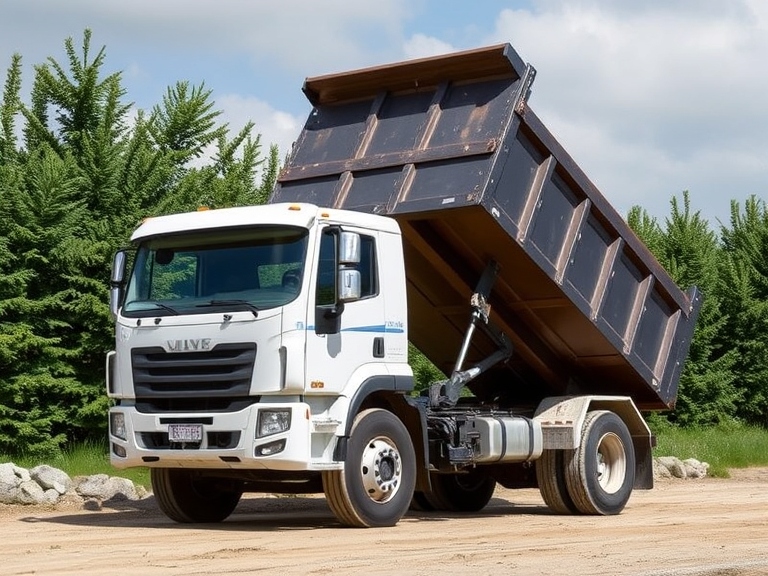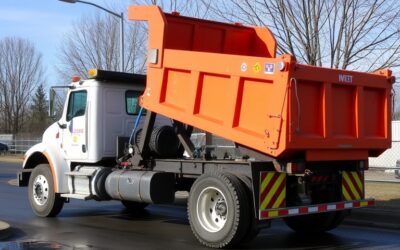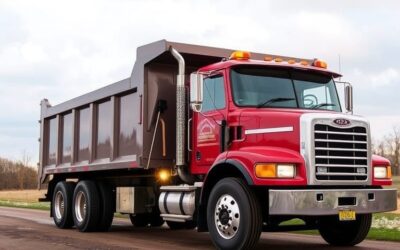Dump trucks are essential in industries like construction and mining, but tipping accidents remain a significant hazard. These incidents lead to injuries, costly delays, and damaged equipment. By addressing the causes—like uneven loads and poor terrain—and adopting solutions like Wink Anti-Tip, you can prevent tipping and ensure safer operations. However, one of the biggest risks associated with dump truck operations is tipping. A tipped dump truck can lead to severe injuries, project delays, and costly repairs. Ensuring these trucks stay upright is vital for safe and efficient work.
There are several factors that can cause a dump truck to tip over. Uneven loading, incorrect driving techniques, and unstable ground conditions can all contribute to instability. Recognizing these hazards is the first step in preventing accidents. By identifying the common causes, we can take appropriate measures to address them and keep trucks stable.
Identifying Common Causes of Dump Truck Tipping
Truck tipping is a major hazard in many industries. Understanding the common causes helps us prevent these dangerous situations. Here are some key factors:
Uneven Loading: Imbalanced loads shift the truck’s center of gravity, increasing tipping risks, especially during unloading. If one side of the truck is heavier than the other, it can easily become unbalanced.
Poor Ground Conditions: Uneven or soft terrain destabilizes trucks, making careful navigation crucial. Rough terrains, potholes, and slopes make it difficult for the truck to stay stable.
Sharp Turns and Sudden Stops: Abrupt maneuvers shift loads dangerously, amplifying tipping risks. Drivers must navigate carefully to avoid these risks.
Weather Conditions: Rain, snow, and wind reduce traction and destabilize loads, making tipping more likely. Slippery surfaces reduce traction, while gusty winds can push the truck off balance.
Mechanical Failures: Issues like worn-out tires, faulty brakes, and suspension problems can also contribute to tipping. Regular maintenance is crucial to keep these systems in check.
Driver Error: Lack of experience or improper training can lead to mistakes. Drivers must understand the truck’s limits and how to operate it safely.
By recognizing these common causes, we can take action to prevent tipping. Monitoring load distribution, maintaining the truck, and training drivers are essential steps in this process.
Best Practices for Loading Dump Trucks
Loading a dump truck correctly is essential to maintain its stability. Following best practices ensures that the truck can handle the load safely. Here are some key loading tips:
Even Load Distribution: Spread the load evenly across the bed to maintain balance, especially on turns and rough terrain. Avoid piling materials to one side or overloading the tailgate area. Balanced loads keep the truck stable and reduce the risk of tipping.
Avoid Overloading: Stick to the truck’s weight limits to prevent stress on suspension and tipping risks. Overloading puts undue stress on the truck and increases the chances of tipping. Use scales to check the load weight if necessary.
Low Center of Gravity: Place heavier materials at the bottom to lower the center of gravity and improve stability. Place heavier items at the bottom and lighter materials on top. This configuration helps maintain balance even on uneven terrains.
Secure the Load: Secure materials with tarps or nets to prevent load shifts during transit. Preventing the load from shifting during transit is vital for stability.
Level the Ground: Load the truck on level ground whenever possible. Loading on slopes or uneven surfaces can create imbalances right from the start.
Check Load Before Moving: Before moving, double-check that the load is secure and evenly distributed. Make adjustments if needed to ensure stability.
Mind the Bed Angle: When unloading, be mindful of the bed angle. Too steep an angle can cause the load to shift suddenly, tipping the truck. Gradually raise the bed and monitor its balance.
These best practices ensure that dump trucks are loaded safely. Taking the time to load properly reduces risks and enhances overall safety on the job site.
Technology Solutions to Enhance Stability
Technology plays a huge role in preventing dump truck tipping. Advanced tools and systems can help monitor and maintain truck stability. Here are some key technology solutions:
Wink Anti-Tip System: Wink Anti-Tip uses advanced sensors to monitor stability and make real-time adjustments, lowering the center of gravity to prevent tipping. When the sensors detect instability, the system automatically lowers the truck’s unit to balance it. This quick response is crucial in preventing accidents.
Load Weighing Systems: Load weighing systems track weight distribution, ensuring balanced loads and preventing overloading. These systems ensure that the truck is not overloaded and that the weight is evenly distributed. Knowing the precise weight helps drivers make informed decisions.
Telematics: Telematics systems provide real-time data on vehicle operation and performance. These systems track things like speed, braking, and cornering. By understanding these factors, drivers can adjust their driving to maintain stability.
Stability Control Systems: Stability control systems automatically adjust suspension and braking to maintain balance. These systems can automatically adjust braking and suspension to keep the truck balanced, even in challenging conditions.
Camera Systems: Installing cameras on the truck gives drivers better visibility of their load and surroundings. Knowing what is happening around the truck helps drivers make safer decisions, especially when maneuvering or unloading.
By integrating these technology solutions, we can greatly enhance the stability of dump trucks. These tools work together to provide real-time data and automatic adjustments, reducing the risk of tipping.
Training and Safety Procedures for Truck Operators
Proper training and adherence to safety procedures are essential for preventing dump truck tipping. Well-trained operators understand the risks and know how to handle their trucks safely. Here are some important training and safety measures:
Comprehensive Training Programs: Train operators thoroughly on dump truck handling, load management, and using stability systems like Wink Anti-Tip. These programs should include both classroom instruction and hands-on practice. Topics should cover load management, safe driving techniques, and understanding stability systems.
Regular Safety Drills: Conducting regular safety drills helps operators stay sharp and prepared for potential tipping situations. These drills should simulate real-life scenarios and teach operators how to respond effectively.
Pre-Trip Inspections: Conduct daily inspections of tires, brakes, and suspension to catch issues before they lead to accidents. Checking tire pressure, brakes, and suspension can prevent mechanical failures that contribute to tipping.
Safe Driving Practices: Encourage smooth driving with gradual turns and steady speeds to minimize tipping risks. This includes driving at safe speeds, making wide turns, and avoiding abrupt stops. Smooth and controlled driving helps maintain truck stability.
Load Management: Operators should be trained in proper load management techniques. Knowing how to evenly distribute and secure the load is crucial for preventing tipping.
Use of Technology: Operators should be trained to use stability-enhancing technology effectively. Understanding how systems like Wink Anti-Tip work and how to interpret data from telematics can improve decision-making.
Emergency Response Training: Operators should know how to respond in case of an emergency. This includes understanding how to stabilize the truck and safely evacuate if needed.
By following these training and safety procedures, truck operators can significantly reduce the risk of tipping. Proper education and regular practice ensure that operators are prepared to handle their trucks safely.
Conclusion
Preventing tipping requires a combination of smart practices, advanced tools, and thorough training. Wink Anti-Tip technology takes safety to the next level with real-time monitoring and automatic adjustments, keeping trucks stable and drivers safe. Equip your fleet with Wink Anti-Tip today to reduce risks and enhance efficiency. By understanding the common causes of tipping, following best practices for loading, leveraging advanced technology, and ensuring proper training and safety procedures, we can create a safer working environment.
Stability is key to preventing accidents and maintaining efficient operations. Tools like the Wink Anti-Tip system play a crucial role in enhancing stability by providing real-time monitoring and automatic adjustments. Operators who are well-trained in safety practices and technology use can make better decisions and keep their trucks stable.
Ultimately, the goal is to reduce risks and protect both the operators and the valuable equipment they use. By taking proactive steps, we can prevent tipping and ensure smoother, safer operations on job sites.
For more information on how Wink Anti-Tip can help keep your trucks stable and your work sites safe, contact us to learn more about our anti-tilt device.





